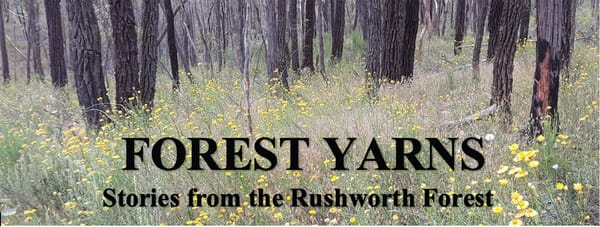The ecology of fallen wood

Loss of habitat is a major driver in the decline of our wildlife populations. Most people only think of habitat in terms of the broader landscape that supports the larger, more visible species of the ecosystem. In truth, habitat and species extend down to include the microscopic level. Habitats must provide for the needs of all the flora and fauna they contain, mostly nutrition, water and shelter. Habitats involve complex webs with the microscopic being their foundations. So how does it work in our own forest here at Rushworth?
At the microscopic level, the forest soil is full of microbes that make nutrients more accessible to plants. The soil also has fungi that have the same role (every species of terrestrial orchids in our forest has a symbiotic relation to a soil fungus attached to its root system that allows it to absorb soil nutrients. The orchids will die without their fungi). Fungi have another very important role. They are one of the few organisms that can break down the cellulose that makes up the cell walls in wood. White ants (termites) can also break down cellulose (or rather the bacteria in their gut can). Breaking down the cellulose allows the nutrients in the wood to be released into the ecosystem.
Our forest is mainly on poor soil (the better land having been cleared for agriculture) so the release of wood-based nutrients is vital for the ecology of the forest and is often the foundation for various food chains. The termites can in turn be eaten by larger creatures such as echidnas, leapfrogging several stages. In a similar way the leaf litter breaks down, almost like a compost heap.
Microbes, fungi and insects play important roles in breaking down the leaves with the white-winged choughs accelerating the process by aerating the leaf litter in their search of food (lyrebirds and bush turkeys have this role in other forests). The freed nutrients support plants and insects that in turn support larger creatures.
We are now in the throes of winter, which seems all the colder after the mild autumn and those of us with wood heaters are finding firewood is becoming a problem. There are fewer suppliers and it has become quite expensive. There is a temptation to go out into the forest and cut up a fallen tree for firewood…and some people do just that…and it is illegal.
To collect wood from the forest you need to buy a permit from DEECA which will allow you to gather wood from designated areas during designated collection periods. It is also illegal to cut wood on the roadside. There have even been cases of people going onto farmers’ properties to cut firewood (in one instance it was a farm where supplying firewood is an important income stream). People who illegally take wood justify their actions by saying that it was only going to waste or that it was a fire hazard that needed cleaning up. What these people fail to understand is that they are not only stealing from DEECA, the local government or the farmer, they are also stealing from the forest.
Every block of wood removed not only removes habitat for small creatures but also nutrients from the forest ecosystem.
If firewood seems too expensive, the above farmer bought chainsaws, a sawbench, a log splitter, a front-end loader and a small truck for his firewood business, not to mention it is his own trees he is cutting up and his time and effort being spent. Is it really so expensive to buy firewood?




